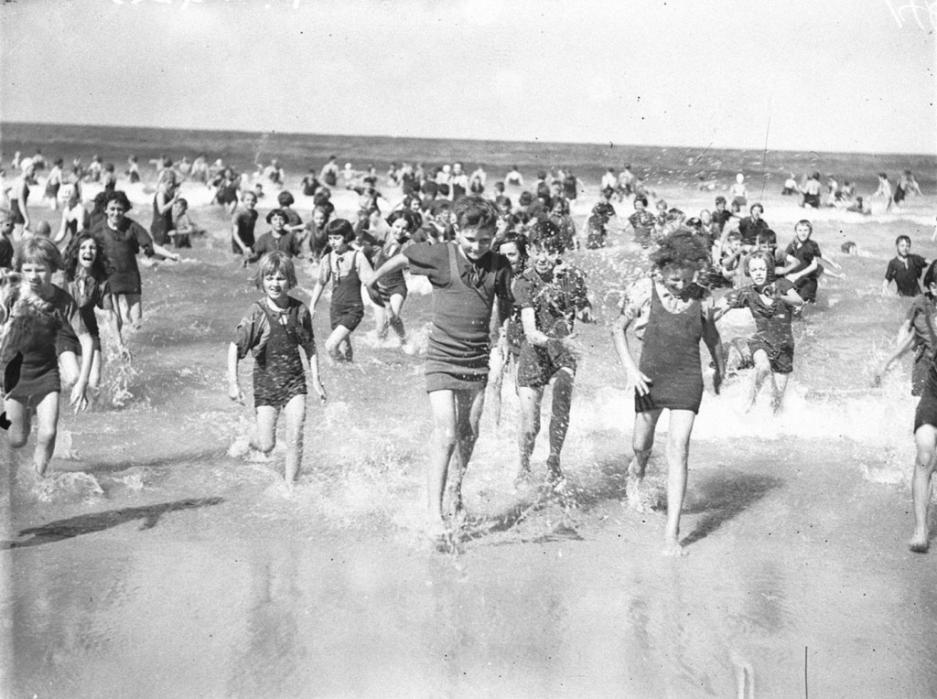Far West Children's Health Scheme - the Formation Years
(or The Benefits of Caring –Born From One Man’s Ideals at Manly)
If you have your health you have everything. Anyone who has battled a debilitating illness or been a carer for a loved one during one of these testing times will not take any moment granted to spend with that loved one after that time for granted.
The health benefits of sea air and saltwater have long been spoken of and once we were, legally, allowed to swim in broad daylight in the sea, ‘Sea Bathing’, this no cost health building benefit saw people take to the ocean and its salty airs in droves. We’re still there.
Sea Bathing for Health. How to get well at the sea-side, or now to improve the health while living near the sea, is a question that should be of interest to many. The cases that may be benefited by a month's residence on some pleasant and bracing part of the coast are very numerous, says an English physician, and include all that partake of the nature of debility either of the nervous or muscular systems, or of the digestive organs. If one be suffering from weakness of any kind, wether from overwork or recent illness, he cannot do better than consider himself to a great extent an invalid while at the sea-side. Rest is of the highest importance. Nature can do nothing without it, and minus medicine of any kind it is often surprising how quickly cases are improved by even a brief residence by the sea, if plenty of time be spent in the fresh air, and baths in the open sea be taken daily. A regular plan or system should be adopted, and firmly adhered to, else but little benefit need be looked for. The cure of no ailment can be accomplished in a hurry. Nature refuses to be rushed. Yet we constantly see people who have been clown at the sea-side return home more jaded and weary than when they left home. The fresh water morning bath should be taken regularly, the sea bath about three hours after breakfast. This is safer than bathing iu the open before breakfast. Too long time should not be spent in the water, especially for the first two or three days. On first taking up one's abode by the sea, inordinate hunger is generally felt. This should not be too much gratified, however, else a bilious attack will be the result, and valuable time lost. Calmness of mind and body, with moderate exercise and freedom from care, will quickly work together for good if regularity and system be thoroughly adopted.
Fresh air and sea bathing are tonics, and all tonics do their work slowly but surely. Sea Bathing for Health. (1895, February 23). Australian Town and Country Journal (NSW : 1870 - 1907), p. 27. Retrieved from http://nla.gov.au/nla.news-article71226097
Once nicknamed the ‘Brighton of the South’, a reference to the famed ‘health resort’ and pleasure place of England, and what an original petition sought as a name for this place– Manly, was no exception to this moniker.
While recuperating on Manly Beach from the removal of his gall bladder, Rev. Drummond had what he described as an inspiration: 'to bring from the Far West to the seaside, children of the kind who would otherwise never see the sea during their childhood'.
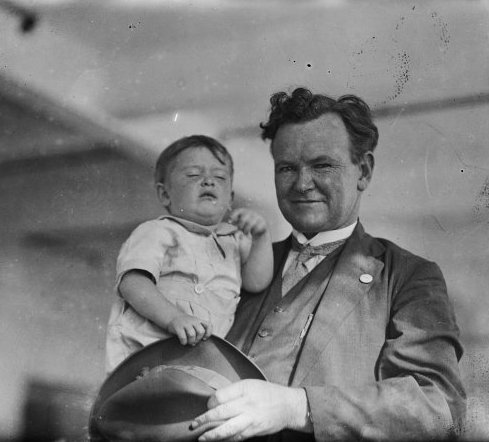 Right: Reverend Stanley Drummond holding a toddler, New South Wales, ca. 1930s, nla.pic-vn6267268 from Fairfax archive of glass plate negatives, courtesy National Library of Australia.
Right: Reverend Stanley Drummond holding a toddler, New South Wales, ca. 1930s, nla.pic-vn6267268 from Fairfax archive of glass plate negatives, courtesy National Library of Australia.
Rev. S. G. Drummond was successfully operated on at Prince Alfred Hospital on Saturday. PERSONAL. (1924, October 3). Western Age (Dubbo, NSW : 1914 - 1932) , p. 2. Retrieved from http://nla.gov.au/nla.news-article137156961
Born on May 22nd, 1884 at Attunga, New South Wales, the eldest son of James Drummond and his native-born wife Mary Jane, née Richardson, his father was born at Beechworth, Victoria, and even though a saddler by trade, he and his wife taught in New South Wales public schools. Stanley was educated at various schools where his father taught, but was not a keen student and on leaving school became a junior clerk in the Department of Lands at Queanbeyan. After contracting pneumonia he followed medical advice and took up outdoor work as a carpenter's assistant.
Although some sources state his decision to enter the Methodist ministry was ‘sudden’, his works would seem to point for a lifelong love of others. He studied at the Sydney Central Methodist Mission, and in late 1909 took charge of the Home Mission station at Bulahdelah. In his first year he was thrown from a sulky, spending eighteen months in pain in an iron splint. Although he recovered he retained a limp. At Bowral on 13 November 1911 he married Lucy Doust, who had been a mission sister at the Central Methodist Mission.
They continued their work on the Rylstone circuit (1914-18), were moved to Canowindra (1919-22) and and then Yass (1923) until moved to Cobar early in 1924.
Wattle Park.(From our Correspondent).FAREWELL TO REV. S. G. AND MRS. DRUMMOND. It was with regret that the folk gathered at the Wattle Park church on 2nd April for the purpose of farewelling Rev. S. G. and Mrs. Drummond prior to leaving for their new circuit in the far west, the former having been the Superintendent Minister for the past twelve months of the Yass circuit of which Wattle Park formed a part. And owing to a division being made by the last conference to the effect that Wattle Park be transferred to the Canberra circuit necessitated the early departure of Rev. Drummond, as Yass is at present supplied with a probation. The recorder, Miss Thelma Southwell, on behalf of the Comrades presented Mrs. Drummond with a beautiful silver jewel case as a token of their love and esteem. ... Mr. C. Kilby expressed a few words of appreciation to Mr. Drummond. He could honestly say the guest had been a true friend to all. His policy seemed to be to get the folk into work, which was a good one as he, himself, had been influenced for the better in that particular direction. On behalf of the young men he could honestly say that they always were glad to see him. They regarded him as a true friend who had won their admiration and esteem. They were indeed sorry to have to separate so soon. Mr. C. Southwell also spoke very highly of Mr. Drummond for his companionship as he regarded him more as a brother than a parson. He had always enjoyed his company and had benefited by his influence and personality. Mr. A. Kilby spoke of the sportsman-ship of Mr. Drummond and his keen interest in all their different kinds of sport, and whilst in the contest of " footy," Mr. Drummond had always been on the lines with the keenest enthusiasm, and they realised they were losing a good sport and barracker. (1924, April 15). Queanbeyan Age and Queanbeyan Observer (NSW : 1915 - 1927), p. 2. Retrieved from http://nla.gov.au/nla.news-article31657152
Mr Drummond was in Sydney recovering until December 19th, 1924 when he is reported to have been 'in good health' by the Dubbo newspaper and returning home. During his stay a few records indicate the size of his parish:
OUT WEST. Life on the Darling River.NEW ERA WITH MOTOR TRANSPORT.
What is the lure out back of beyond, west of the Darling, for those clear-eyed clear-headed men who, having once experienced the freedom of the vast silences, never seem to desire to come any nearer to civilization - men who need from 30,000 to 60,000 acres for a living area, and spend a year or more, maybe, without seeing a drop of rain."I am over 60 years of age," said one of these veterans, talking one day to the Rev.S. G. Drummond, of the Far West Mission, Cobar, "and I'm living now within a stone’s throw of the place where I was born - I’ve lived here all my life, and I suppose I shall die here!" Another found almost at death’s door in his lonely hut, on the spot where he had lived for 50 years, pleaded hard to be allowed to remain there to die rather than be taken to a hospital, even with the chance to live. Civilisation surely crowds in on these men - even the country east of the Darling, where you can be content with 5000 acres of land, seems congested to them.
Mr. Drummond, young and himself imbued with that genial optimism which must prove an indispensable asset in life out west, is now visiting Sydney, and tells graphically of the scenes he has witnessed in the isolated territory of his mission, one of the three inland missions established by the Methodist Church in New South Wales, and by far the largest. The area under his administration runs from Nyngan to the South Australian border, and from the Condobolin-Menindie line, now under construction, to the Queensland border - an enormous territory, where they measure distances not by miles, but by hours.
"You ask how far a place is," says Mr.Drummond, "and they tell you, 'Oh, about 10 hours.' It puzzled me at first, but it puzzles them to talk of miles. When one man told me that he lived 'six hours' away, I pointed out to him that I didn't know how far that was, and asked him, 'What's the distance in miles?' He didn't know. 'How many miles is it, Bill?' he inquired of his friend, who was almost as nonplussed as he was. Finally they reckoned that it must be from120 to 160 miles. The settlers grow accustomed to 'magnificent distances' in that country. I suggested to one man, who was contemplating a railway journey, that he should travel by way of Cobar, but he laughed at the suggestion. 'Oh,' he explained, 'I just run down the creek and catch the train near my place. It comes along the creek, and it's much handier.' When I inquired further, I discovered that it took him 12 or 13 hours to catch the train at the spot which he had described as 'much handier.' " OUT WEST. (
1924, December 13).
The Sydney Morning Herald(NSW : 1842 - 1954), p. 10. Retrieved from
http://nla.gov.au/nla.news-article16196666 The first ‘camp’ is reported to have been in Cronulla and commenced February 4th, 1925:
CHILDREN OF THE BUSH. Day in the City. The first party of country children and mothers brought from Cobar and beyond, under the scheme organised by the Rev. Stanley Drummond, assisted by Dr. Arthur, M.L.A., and Mr. A. E. Hunt, M.L.C., arrived in Sydney a t5.30 on Wednesday morning. The 56 children in the party, which numbered 65, were bright and enthusiastic after their 20 hours of travel, and showed marked interest in all the new things they saw around them. Dr. Arthur, Mr. Hunt, Mr. A. TJ. Ross, and members of the Women's League, including Mrs. G. Dale, Mrs. Roberts, and Mrs. Carpenter, attended to the wants of the party, who were afterwards taken to Cronulla by cars provided by the Royal Automobile Club. Rev. S. J. Stanley (Far West Mission) and Mrs. Drummond were in charge of the visitors on the journey down and Rev. P. Hawkins(Bush Aid Society) accompanied them. Appreciation was expressed by Mr. Drummond of the action of the Railway Commissioners in sending a corridor carriage, which enabled the children to be kept under supervision.
Gifts of fruit and sandwiches were made to the children by groups at various stations en route, and at Dubbo a number of residents arranged for a hot meal, to be served to the party at the railway refreshment rooms at night. Among the children was one little boy, Keith Blacker, who had ridden two hundred miles to join the party. Other children had come from long distances to Cobar. The mothers all had young children to care for while on the holiday, but were looking forward to the change and respite from inland conditions. The children were divided into two parties at Cronulla. Some are occupying the home lent by the social service committee of the Church of England Men's Society, others are in the seaside home of the City Mission. The mothers are occupying a furnished cottage. CHILDREN OF THE BUSH. (
1925, February 6 - Friday).
The Land(Sydney, NSW : 1911 - 1954), p. 5. Retrieved from
http://nla.gov.au/nla.news-article103032497
CHILDREN OF THE FAR WEST.
TO THE EDITOR OF THE HERALD.
Sir,-The Social Service Committee of the Church of England Men's Society has been making a magnificent contribution to the success of the Far-West holiday scheme, organised by Mr. A. E. Hunt, Dr. Arthur, and Rev. S. G. Drummond. Fourteen children and a supervisor are the guests of the Social Service Committee for two weeks at the children's home of the committee at Cronulla. The committee has offered the home to another batch from the West for a term of two weeks as its guests. The home, under its able matron, is carrying out magnificently the object for which it was established. It is in many cases more than "a home from home." The best influences are brought into the lives of the children. Its management is a credit to the church. Its equipment is not quite complete, which is quite obvious, because the home is in its infancy. The extension of the good work means the construction of new buildings on a new site. The children are always grateful for the attention and interest of the matron. There is no stinting in the way of food, and in fact the staff is always pleased to adapt itself to the demands of the increased appetites, owing to the beneficial change. The children leave the institution healthier, happier, and wiser. Their short stay will leave its impression on the children for the rest of their lives. It is a fact that children want to stay again at the home.
I am, etc.,
(Rev.) B. R. HAWKINS, C.E.M.S.,
Children's Holiday Home,
Feb. 13. - Fleischer-street, Cronulla.
By the following year :
CHILDREN OF THE FAR WEST.
The Rev. S. G. Drummond, superintendent of the Far West Mission of the Methodist Church of Australasia, which embraces Bourke, Wilcannia, Cobar, White Cliffs, and the surrounding districts, writes to state that it is proposed early in the new year to take a party of children to the seaside. The selection will be made on exactly the same basis as on other occasions, viz., children, irrespective of denomination, over ten years of age and under 14, who have not previously seen the sea, or who, for health reasons, require a change or special treatment not available locally, and whose parents, having extremely limited means, are unable to give their children what it is hoped to provide. Last summer nearly 200 benefited by the scheme, some results being remarkable. Mr. Drummond wants to get the children to the seaside early in January, if possible, so that the trip may be over before the schools re-open.
"This morning," he writes, "the temperature was 106 degrees at 8 o'clock, and at 4 o'clock in the afternoon it is 110 degrees. Will the folk better situated spare us something to take from the hot and dry Far West to the glorious ocean those little ones who have as yet never seen the sea, and who, in the opinion of medical men, would physically benefit by such a change? We would be glad to receive donations at once, if practicable, so that we may know how many children can be taken and make our arrangements accordingly." Gifts of money may be forwarded to the Rev. S. G. Drummond, at the Far West Mission, Cobar. CHILDREN OF THE FAR WEST. (1
925, December 10).
The Sydney Morning Herald (NSW : 1842 - 1954), p. 9. Retrieved from
http://nla.gov.au/nla.news-article16260442
FAR WEST CHILDREN. PARTY COMING TO SYDNEY. COBAR, Tuesday. Under the far-west mission seaside scheme 80 children, carefully selected on account of circumstances and need of a change for health reasons, left for Sydney this morning. They are travelling by train under the supervision of the Rev. Stanley Drummond. They will stay at Manly for a fortnight. FAR WEST CHILDREN. (1926, January 13). The Sydney Morning Herald (NSW : 1842 - 1954), p. 21. Retrieved from http://nla.gov.au/nla.news-article16270234
The children would be supplied with navy blue swimsuits with ‘FW’ on their backs to help with easy identification, and under these would wear brown shirts to prevent sunburn.
To fund such a wonderful scheme appeals were made:
CHILDREN OF THE FAR WEST.
TO THE EDITOR OF THE HERALD.
Sir,-May I encroach on the limited space in your valuable paper to commend to your readers the seaside scheme for children organised by the Far West Mission. Eighty children in reduced circumstances, after medical examination, have been carefully selected by doctors, municipal and hospital authorities, teachers, and other representative persons, on the grounds of health and circumstances, irrespective of religious denomination, to go to the seaside. Nearly half of these children are being conveyed anything from 50 to over 250 miles to reach the train, some having commenced their long journey on the 7th instant. Very few of them, if any, have ever seen the sea. They will all reach Sydney on Wednesday morning, 13th instant, and be housed for a fortnight at Manly. Railway fares are being charged as on former occasions -namely, one-third single fare each way. However no expense whatever falls on the child.
Those who sympathise with the object of trying to build up our less fortunate and delicate children (one small boy has under-gone 14 surgical operations) that they may become fit, as men and women, to do battle for the State in the far west, would do well to send assistance immediately to Rev. S. G. Drummond, Far West Children's Camp, careof P.O., Manly, or to the hon. treasurer, Mr. Gordon Winn, Box 1002, G.P.O., Sydney.
I am, etc,
C. O'NEILL,
Council Chambers, Cobar, Jan. 11. Mayor.
CHILDREN OF THE FAR WEST.
TO THE EDITOR OF THE HERALD.
Sir,-May I be permitted to place before your readers the seaside health scheme for children of the far west, originated and organised by the Far West Mission, whose operations cover an area of about 100,000 square miles of the back country of New South Wales.
The objects of our scheme are twofold: -Health and education. In three trips over 250 little folk, mostly between the ages of 10 and 14, have been taken to Sydney, where they got their first glimpse of the sea. Of 80 taken to Manly last January one-half suffered teeth extractions and fillings, 15 were treated by specialists for eye complaints(four being provided with glasses), and seven had minor operations under an anaesthetic.
Only children of parents in very limited circumstances are selected for the trip, preference being given to those in most need from the standpoint of health and means. A good selection is assured through the sympathy and co-operation of the medical profession, the Education Department, bush nurses, clergy, and others. No discrimination on account of religious convictions is tolerated.
Arrangements are being made to take 80 children to Manly, where, through the courtesy of Mr T. D. Mutch (Minister for Education) and Mr Brown (headmaster) they will camp at the Manly Public School from January 5 to January 19. We need financial assistance to meet the cost of motor transport, railway fares, and keep. Several motherless children, booked already for the trip, live on a "block" over 150 miles from the nearest doctor, dentist, picture show, church, railway, etc. They have never seen a town. Others will have to be brought 400 miles by car to catch the train at Cobar. One lad, most anxious to see the sea, was born at Sandy Soak, out Birdsville way, and has come "close in" to live on the land 300 miles west of Bourke.
In the spirit of Christmas I would ask your readers to help us to bring health and happiness to the sick and needy living under conditions, climatic and otherwise, often far from congenial. Donations addressed to the under-signed or to the treasurers, Messrs. Winn and Robson, c.o. Winns, Ltd., Oxford-street, Sydney, will be gratefully acknowledged.
I am. etc.,
STANLEY G. DRUMMOND,
Superintendent Far West Mission.
Cobar, Nov. 27.
A permanent home for the children needed to be established. Although the camp at Manly School was great for those brought to rejuvenate their health in a seaside air and saltwater, and continued, a focus on children who needed to come to Sydney for health reasons, meant that rooms with rooves were needed for those children who needed to recuperate. This is also allowed the Health scheme to become a year round support system for the children and their families:
FAR WEST CHILDREN ON HEALTH VISIT TO MANLY.Above: Children from the outback areas of New South Wales ready to enjoy a dip in the surf. The organisers of the Far West Children's Health Scheme are catering for about 170 children, who are quartered in the Manly public school, during the holiday period. FAR WEST CHILDREN ON HEALTH VISIT TO MANLY. (1935, December 24). The Sydney Morning Herald (NSW : 1842 - 1954), p. 12. Retrieved from http://nla.gov.au/nla.news-article17229431 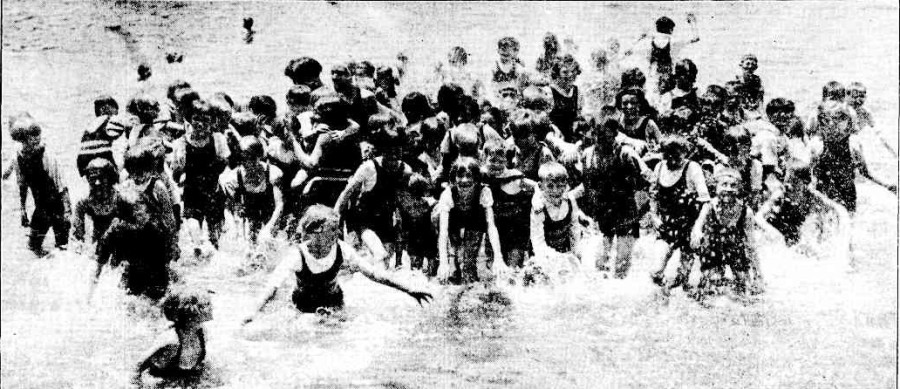
CHILDREN FROM THE FAR WESTERN DISTRICTS VISIT THE SEASIDE FOR THE FIRST TIME. BOYS AND GIRLS FROM NYNGAN AND BEYOND, BROUGHT TO SYDNEY UNDER THE FAR WEST CHILDREN'S SEASIDE HEALTH SCHEME, ENJOYING THE SURF AT MANLY YESTERDAY. The party comprises 100 children, who are camped at the Manly Public School. They are in charge of the Rev. S. G. Drummond and Mrs. Drummond. CHILDREN FROM THE FAR WESTERN DISTRICTS VISIT THE SEASIDE FOR THE FIRST TIME. (1928, December 28). The Sydney Morning Herald (NSW : 1842 - 1954), p. 12. Retrieved from http://nla.gov.au/nla.news-article16519555
REV. S. G. DRUMMOND AT MOREE. MOREE, Tuesday. The Rev. S. G. Drummond, organiser of the far west children's health scheme, arrived at Moree yesterday to see if there were any children needing medical treatment. Members of his association help to pay the expenses of children to go to Sydney and receive the treatment of specialists if their parents are notable to pay. The association has been working over an area of 25,000 square miles, from Walgett to Hillston. There are 34 patients in 11 hospitals in Sydney. In the last three days, said Mr. Drummond, he had come across three crippled children who were in need of treatment. The association had a home at Manly, which would be opened on October 12. COUNTRY NEWS. REV. S. G. DRUMMOND AT MOREE. (
1929, October 2).
The Sydney Morning Herald (NSW : 1842 - 1954), p. 16. Retrieved from
http://nla.gov.au/nla.news-article16589134
CHILDREN OF THE WEST. NEW HOME AT MANLY.
"I am particularly struck with the splendid spirit of those who are working so hard and with such success for the children who, had it not been for the Rev. S. G. Drummond, would still have been suffering in silence away out in the far west," said the Minister for Education (Mr. Drummond) at the opening of the home which has just been acquired in Wentworth-street, Manly, under the far west children's scheme.
The home, which has been fitted up to accommodate a dozen children, principally those who are receiving outdoor attention at hospitals and those who are convalescent after operations and treatment, is furnished with dormitories for boys and girls, with a central common room for dining and recreation. It is expected that the home will be fully occupied all the year round. There was a large gathering, presided over by Mr. G. R. Wynne, who said that though financial support for the scheme was one of the prime necessities, yet personal service was of equal importance. That, he was glad to be able to say, was being given ungrudgingly by physicians, surgeons, dentists, and others, without whose help it would be impossible to carry on. The Rev. S. G. Drummond mentioned that one boy who had lost his sight and came down from the country to be trained at the Institution for the Blind, had been diverted to hospital, where an operation had proved so successful that his sight was now partly restored. CHILDREN OF THE WEST.
(1929, October 14).
The Sydney Morning Herald (NSW : 1842 - 1954), p. 8. Retrieved from
http://nla.gov.au/nla.news-article16592775
CHILDREN FROM THE FAR WEST AT THE SEASIDE. At Manly public school yesterday. Many of the youngsters, who have been brought down under the Far West Children's Health Scheme, are visiting the seaside for the first time. The Rev. S. G. Drummond and Mrs. Drummond are in the centre. CHILDREN FROM THE FAR WEST AT THE SEASIDE. (
1929, December 30).
The Sydney Morning Herald (NSW : 1842 - 1954), p. 12. Retrieved from
http://nla.gov.au/nla.news-article16613830
Demand required a bigger premises and the raising of funds for this building scheme. This was an ambitious project and attracted support from all quarters to raise the funds needed and get the work done. As with our own community hospital at Mona Vale, every penny counted:
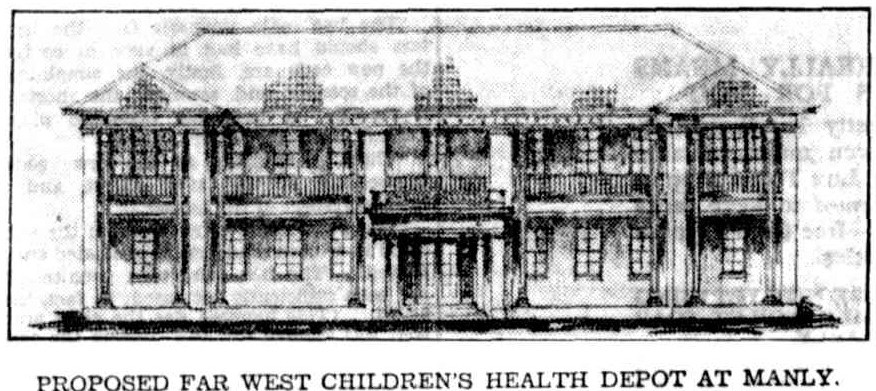
FAR WEST HEALTH SCHEME. Many suggestions for helping the Far West Children's Health Scheme building fund were made at a meeting held at Government House yesterday morning. Lady Game offered roots and cuttings of lavender from her gardens at Government House and at Sutton Forest, and these were eagerly accepted by gardeners, who will grow them, and sell the flowers for the benefit of the fund.
Mrs. Warner, of Wahroonga, has propagated a new dahlia bulb, Phar Lap, which she will sell at 5/ each, the proceeds of the sales to go to the building fund. Miss Myrine Collins offered to organise an afternoon party on July 22, and has been offered a ship for the occasion.
Mrs. Sydney Herring outlined a scheme for establishing in each suburb a committee of 12, directed by a group captain, which will organise an entertainment, and, later on, the whole group of workers will co-operate in one big effort for the building fund. Lady Game consented to be the commander-in-chief of this brigade of workers, and Lady Street, campaign general. A sub-committee was appointed to organise this activity.
Plans were also discussed for the fete at Quambi, Edgecliff, the residence of Sir Kelso and Lady King, on October 28. Stalls will be allotted to fete workers at a committee meeting at the Hotel Australia on May 17. FAR WEST HEALTH SCHEME. (
1933, April 27).
The Sydney Morning Herald (NSW : 1842 - 1954), p. 4. Retrieved from
http://nla.gov.au/nla.news-article16971695
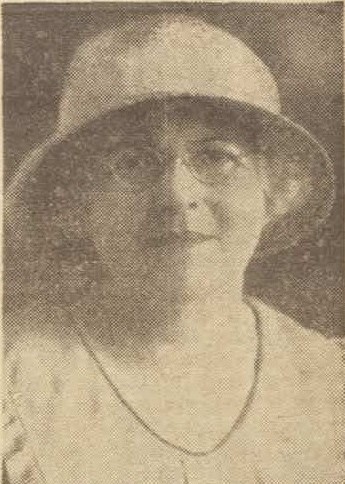 Far West Health Scheme. MRS. S. F. DRUMMOND, whose husband, the Rev. S. Drummond, was included in the King's Birthday honors. Many country hearts were glad to see the name of the Rev. Stanley Drummond, M.B.E., among the King's Birthday honors list. The honor is really a dual one, for Mrs. Drummond has shared in the fine work of her husband. To be freed from physical ills and able to look forward to a normal, healthy and happy life, has been the lot of many hundreds of children in the out-back districts, who have come under the ministrations of the Far West Children's Health Scheme.
Far West Health Scheme. MRS. S. F. DRUMMOND, whose husband, the Rev. S. Drummond, was included in the King's Birthday honors. Many country hearts were glad to see the name of the Rev. Stanley Drummond, M.B.E., among the King's Birthday honors list. The honor is really a dual one, for Mrs. Drummond has shared in the fine work of her husband. To be freed from physical ills and able to look forward to a normal, healthy and happy life, has been the lot of many hundreds of children in the out-back districts, who have come under the ministrations of the Far West Children's Health Scheme.The scheme, which is now an organised unit in the community, with headquarters established at Manly, originated with Rev. Stanley Drummond when he was convalescing, after a serious illness, at Manly in 1924. A seaside camp was arranged under the guardianship of Mr. and Mrs. Drummond, with 64 outbackers enjoying every moment of their lives. It was soon discovered, however, that some of the little ones were suffering from various ills. The young sufferers were not sent home forthwith, as Macquarie Street doctors were interested and proved their practical sympathy by setting the little people on the way to recovery. So a health scheme grew out of a holiday idea, and the chief object of the scheme became one of curative treatment, as the children, instead of being debarred by sickness from the trip, were chosen according to their physical needs. A home depot was established at Manly for the children, and Mr. Drummond left his church in order that he and his wife could devote the whole of their time to organising the work and escorting the children on their journeys.
TO ASSIST THE FUNDS
To assist the funds of the movement, the following entertainments have been arranged. On June 12, the Croydon Ladies' Social Club will hold a ball at the Ashfield Town Hall. The Governor and Lady Game, who are keenly interested in the work, will be present. On June 16, Mrs. Bradfield will speak at her home, 23 Park Avenue, Gordon, on "Building the Bridge." On July 23 there will be a musicale and dance on the Nieuw Zeeland, and on October 28 a garden fete will be held at the home of Sir Kelso and Lady King, Edgecliff. The city office address of the Far West Children's Health Scheme is at 14 Castlereagh Street, Sydney. Far West Health Scheme. (1933, June 10). The Australian Women's Weekly (1933 - 1982), p. 24. Retrieved from http://nla.gov.au/nla.news-article48074517
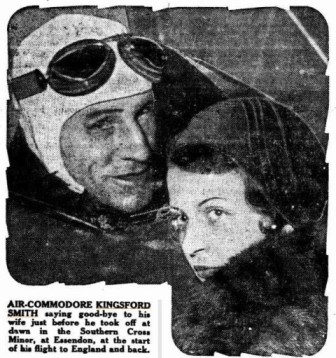 Kingsford Smith's Generosity. THE N.S.W. Far West Children's Health scheme has benefited by over £1100 as the result of Air Commodore Sir Charles Kingsford Smith handing over to it the proceeds of a fund inaugurated by the citizens to recognise his air services to Australia. The money, which was to have been spent on a testimonial to the airman, will now be devoted to the erection of a building for the care of feeble country children. The organising committee, of which the Lord Mayor (Alderman Hagon)was chairman, decided that some memento should be presented to Sir Charles Kingsford Smith, chiefly for his generous action, and at a recent representative gathering at the Town Hall recently he was given a figured maple writing desk and chair with his name inscribed on a gold plate fitted to the top of the table. Men and Matters. (1933, July 26). Worker (Brisbane, Qld. : 1890 - 1955), p. 13. Retrieved from http://nla.gov.au/nla.news-article71140452
Kingsford Smith's Generosity. THE N.S.W. Far West Children's Health scheme has benefited by over £1100 as the result of Air Commodore Sir Charles Kingsford Smith handing over to it the proceeds of a fund inaugurated by the citizens to recognise his air services to Australia. The money, which was to have been spent on a testimonial to the airman, will now be devoted to the erection of a building for the care of feeble country children. The organising committee, of which the Lord Mayor (Alderman Hagon)was chairman, decided that some memento should be presented to Sir Charles Kingsford Smith, chiefly for his generous action, and at a recent representative gathering at the Town Hall recently he was given a figured maple writing desk and chair with his name inscribed on a gold plate fitted to the top of the table. Men and Matters. (1933, July 26). Worker (Brisbane, Qld. : 1890 - 1955), p. 13. Retrieved from http://nla.gov.au/nla.news-article71140452
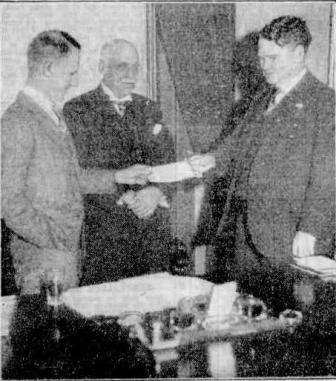 FAR WEST CHILDREN'S APPEAL. From left: Sir Charles Kingsford Smith, the Lord Mayor (Alderman Hagon), and Rev. S. G. Drummond at the Town Hall yesterday. FAR WEST CHILDREN'S APPEAL. (1933, July 22). The Sydney Morning Herald (NSW : 1842 - 1954), p. 16. Retrieved from http://nla.gov.au/nla.news-article16993205
FAR WEST CHILDREN'S APPEAL. From left: Sir Charles Kingsford Smith, the Lord Mayor (Alderman Hagon), and Rev. S. G. Drummond at the Town Hall yesterday. FAR WEST CHILDREN'S APPEAL. (1933, July 22). The Sydney Morning Herald (NSW : 1842 - 1954), p. 16. Retrieved from http://nla.gov.au/nla.news-article16993205
Morrow and Gordon have placed contracts with E C. McClintock for a concrete base for machinery in a factory in Pier-street, Darlinghurst; for alterations to premises, 35 Oxford street; and for alterations to premises, 160Pitt-street. They have placed with E. and R. Ellis the contract for erection of the home for Far West children at Manly, and with E. P. Wainwright, Lakemba, the contract for demolishing the building now on the site. NEW WORKS. (1934, July 3). The Sydney Morning Herald(NSW : 1842 - 1954), p. 7. Retrieved from http://nla.gov.au/nla.news-article17096200
FAR WEST-HOME - SCHEME. At the laying of the foundation stone at Manly on October 6, - a sterling tribute was paid by eminent speakers to the wonderful work of the Superintendent (Mr. S- G- Drummond)… under whose supervision the scheme has developed so marvellously and assumed great possibilities of the Drummond Far West Home Scheme. The Foundation Stone was laid by the Premier (Mr. B. S. R. Stevens)In the presence of a large gathering, including Lady Game, the president of the Far West Building Fund Committee. In opening the proceedings Mr. Drummond said that he was delighted to see such a large gathering. , It gave him an opportunity of expressing his deep appreciation to the ever-widening circle of friends. They one who had been intimately associated with the scheme since its inception — twelve years ago. He had successfully conducted no less than 150 operations on behalf of the children of the Far West. Mr. Drummond presented Dr. Barron with a gavel, made from Far Western timber and suitably Inscribed. Dr. Barron, on rising to respond, said he had had something to do with the arrangements that afternoon, but knew nothing of the presentation from the children. He appreciated their good wishes, but desired them to know that his work had always been a pleasure. It was a great scheme and well worthy of assistance. The ceremony of laying the foundation stone of the Drummond Far West Home marked an epoch in the history of the organisation, for a considerable period they had been cramped in the old depot, their ambition had been a new building, which he hoped would soon be opened. Committee's Felicitations Felicitations were offered by Hon.Dr. Wilfred Vickers to Lady Game, president of the Building Fund Committee whose interest in the scheme had been maintained ever since her arrival in Australia. He also wished he continued, to pay a tribute to Lady Hore Ruthven, who would bean excellent successor to Lady Game. He wished also to thank thc building committee for its gift of £3000. 'I wish the scheme every success in the |great work it is carrying on,' he concluded.
Representative Gathering; The chairman of the Far West Council, Dr. G. Moncrieff Barron, was chairman on this occasion, and with him on the official platform were, Her Excellency, Lady Game, the Hon. B. S. R. Stevens. nnd Mrs- Stevens, the Lady Mayoress (Mrs. Parker),the Mayor and Mayoress (Mr. and Mrs. Seller), the Hon. H. M. HawkIns, M.L.C., Mr. A. Reid, M.L.A., Mr.A. Yeo, M.L.A., Rev. A. R. Ebbs, Rev.|A. J. Burt, Rev. Father McDonald, P.P., Drs. Lennox - Teece, Wilfred Huff Johnston (hon. surgeons), G. R. Winn (joint hon. treasurer), Sir Thomas and Lady Henley, the –Manly District Hospital was represented by Mr. J. M. Lane, Mr. and Mrs. S. G. Drummond. Congratulatory telegrams were read by Mr. Drummond from the Far West committees in Dubbo, Coonamble, Trangle, Hermidale, Coonabarabran, Broken Hill (which also forwarded a cheque for £219), Barradine, Mungindi, Narrabri, Collarenebri and other centres. FAR WEST HOME. (
1934, October 29).
The North Western Courier (Narrabri, NSW : 1913 - 1954), p. 3. Retrieved from
http://nla.gov.au/nla.news-article133265997 FAR WEST HOME AT MANLY. Additions Opened. UNFINISHED WALLS.
"I had a speech typed out like the men, but I have forgotten every word of it," said Mrs. S. G. Drummond, on Saturday afternoon, when she spoke instead of her husband at the opening of the additions to the Far West Home, at Manly. After Mrs. Drummond had paid tribute to the wonderful work done by the matron, Mrs. E. E. Hill, she handed to Sir Philip Street, who was accompanied by Lady Street, a golden key, with which he opened the door of the new block. Sir Philip and Lady Street inspected all the new portion of the home, showing particular interest in the synoptophore, a machine for treating children with muscular eye trouble, at which they both sat while Miss Ivy Martyn demonstrated how it worked. The colourings of the new wing, which are mostly soft yellows and greens, have all been used in accordance with the wishes of the honorary eye specialists of the home, and are designed to rest the children's eyes after the glare of the Far West.
KITCHEN DIVIDED. Of interest to women is the divided kitchen, which is so planned that the preparation of cold foods takes place in a separate compartment. The observation wards are built to accommodate two beds in each and to have as much air as possible. There is an average of a window per bed. Outside the observation wards is a roof playground, where children under observation can play in seclusion from the other children in the home, and a big indoor playground for wet days is provided as well.
The laundries and drying rooms form the topmost part of the building, with lines out-side on the flat roof, and are equipped with every modern device.
UNFINISHED WALLS. Rather forlorn looking are the walls of the last part of the building, which have been erected in order to place the tanks in position: but which cannot be completed until there are enough funds. The walls stand with gaping holes where some day will be big windows. One of the most interested people to go through the new wings was the Mayor of Bourke (Alderman S. Coleman).
After the inspection afternoon tea was served to the members of the official party by members of the Manly Far West younger set, of which Miss D. Aiken is president and Miss Dorothy Farr is honorary secretary. Included in the official party were Sir Philip and Lady Street, the Lady Mayoress (Mrs. George A. Parkes), Lady Parker, Dr. and Mrs. A. Moncrieff Barron, Dr. and Mrs. W. Vickers, Mr. and Mrs. R. Malloch, Dr. and Mrs. Lindsey Dey, Rev. S. G. Drummond's mother, Mrs. M. J. Drummond, Mrs. J. Carter (Dubbo), Mesdames George Lee, W. G. Matchett, and W. E. Hopkins, Miss Judith Adamson, Miss Stephanie Edye, and the Rev. A. R. Ebbs. FAR WEST HOME AT MANLY. (
1937, November 8).
The Sydney Morning Herald (NSW : 1842 - 1954), p. 5. Retrieved from
http://nla.gov.au/nla.news-article17413732
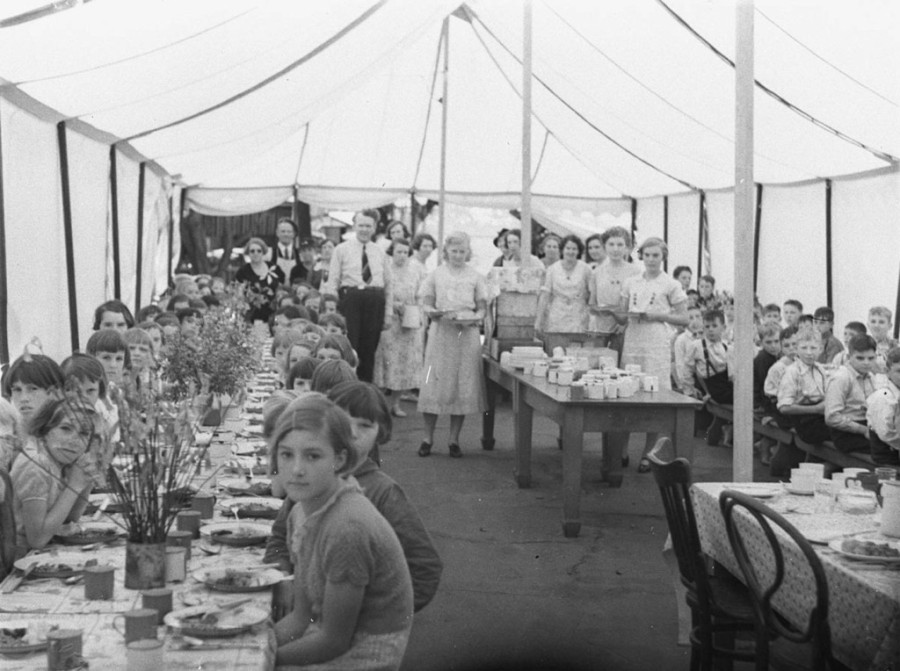
Far West children having their first meal at Manly in a marquee, by Ted Hood, 27 Dec 1934. Image No: hood_01417, courtesy State Library of NSW.
As well as attending to individual health needs, diseases which sweep as epidemics to afflict children were part of what the health focus attended to.
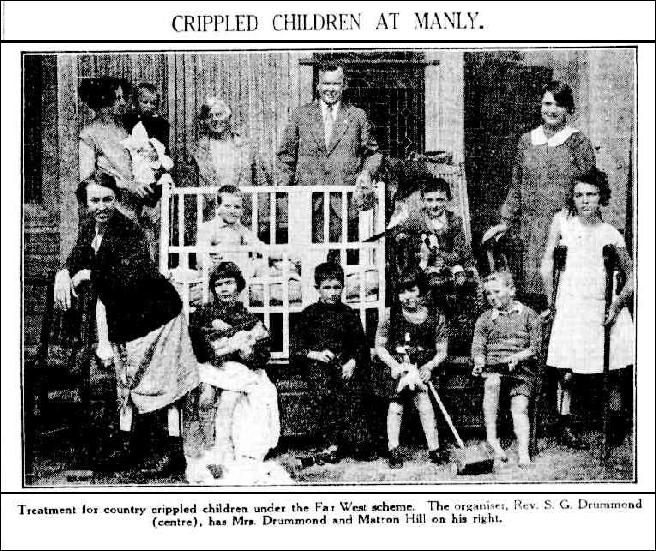 FAR WEST HEALTH SCHEME.
FAR WEST HEALTH SCHEME.The Rev. S. G. Drummond, of the Far West children's health scheme, returned to Sydney with Mrs. Drummond yesterday after a journey of 3500 miles by car and train in the inland parts of New South Wales. As a result of the trip seven patients have come to Sydney for expert medical treatment. Four of them are suffering from the effects of infantile paralysis, contracted many years ago, and the others have eye and nerve trouble. FAR WEST HEALTH SCHEME. (
1930, June 7).
The Sydney Morning Herald (NSW : 1842 - 1954), p. 19. Retrieved from
http://nla.gov.au/nla.news-article16667008
CRIPPLED CHILDREN AT MANLY. Treatment for country crippled children under the Far West scheme. The organiser, Rev. S. G. Drummond (centre), has Mrs. Drummond and Matron Hill on his right. CRIPPLED CHILDREN AT MANLY. (
1930, April 15). The Sydney Morning Herald (NSW : 1842 - 1954), p. 14. Retrieved from
http://nla.gov.au/nla.news-article16666290
Far West Home Treats Child Migrant Polio Cases. Child victims of the polio epidemic have been sent from migrant camps at Bathurst and Wagga to the Far West Children's Health Home, at Manly, for special treatment. During the previous infantile paralysis epidemic, remarkable results were achieved .at the Far West Home, Manly, when more than 70 cases were treated, and for this reason the home has been asked to undertake similar treatment in the present wave of the disease. Although the home and holiday, camps are mainly reserved for children from far western areas more than 300 miles from the sea, all other benefits, including the treatment of infantile paralysis cases, are available to handicapped children from all over country areas. Thus little "new Australians" from migrant camps, have become "far Westers" for the term of their illness. Far West Home Treats Child Migrant Polio Cases. (
1950, March 3).
The Land (Sydney, NSW : 1911 - 1954), p. 26. Retrieved from
http://nla.gov.au/nla.news-article105720153
Dr. Drummond passed away a few months after his wife in 1943. His brother, a long-term advocate of his work, continued his support until he too passed away:
GOOD MAN GONE. REV. S. G. DRUMMOND - His Work Will Be Remembered.
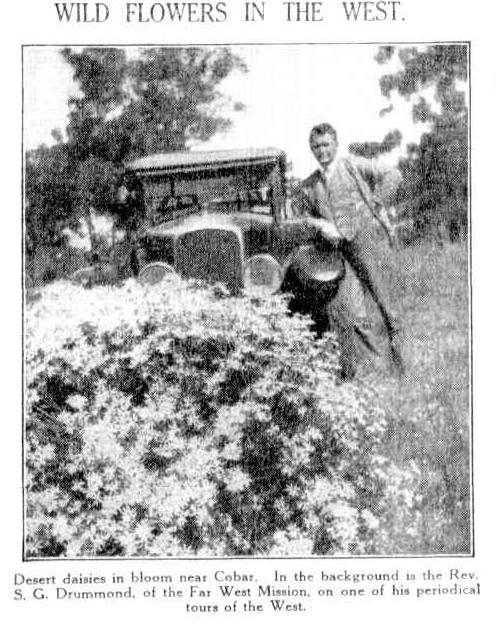 Rev. Stanley G. Drummond, Founder of the Far West Children's Health Scheme, has passed over to the Great Beyond, beloved and remembered by people scattered in all parts of New South Wales. Fifty-eight years old when the Call came, this fine self-sacrificing personality spent the adult years of his life doing good to others, irrespective of creed, class or color. There was nothing too strenuous, too hazardous, or too costly where humanity was concerned that Stanley Drummond did not undertake to accomplish.
Rev. Stanley G. Drummond, Founder of the Far West Children's Health Scheme, has passed over to the Great Beyond, beloved and remembered by people scattered in all parts of New South Wales. Fifty-eight years old when the Call came, this fine self-sacrificing personality spent the adult years of his life doing good to others, irrespective of creed, class or color. There was nothing too strenuous, too hazardous, or too costly where humanity was concerned that Stanley Drummond did not undertake to accomplish.Helped immeasurably by a devoted wife—called to her Maker a few months ago—the inspiration to evolve some means whereby the children of the Far West might enjoy comfort, treatment, and relaxation was quickly moulded into a real concrete workable form.
Although faced with the spectacle of increasingly heavy upkeep associated with an undertaking of gigantic proportions the man who is now no more never once baulked in his determination to see the project through.
What a noble project! The inauguration of a scheme that would not only bring restoration, physically, to children in the back country—many of whom had not previously seen Sydney nor its glorious seaside resorts—but unlimited solace to those parent whose slender mean often debarred them from bringing their afflicted offspring to the metropolis.
Since the founding of the Far West Scheme in 1925 Mr. Drummond had the consolation of knowing that close on 3,000, children from outback areas had received expert medical treatment at Manly, while more than 2,000 little ones participated in holiday camps arranged by him and his estimable wife.
Nor even the illness which eventually extracted the last breath of life deterred Stanley Drummond from persevering in his efforts to alleviate suffering humility. During the early stages of the Scheme he and Mrs. Drummond experienced great hardships, typical, in many respects, to the vicissitudes encountered by the early pioneers. Theirs was a work of mercy, benevolence and kindness, deviation from which, in face of apparently Insurmountable barriers, was, on no occasion contemplated.
When last in these parts the late Stanley Drummond mentioned that too much stress had been given by well-meaning public speakers to the part he had played in connection with the Far West Children's Scheme. On one occasion be remarked modestly: 'The original inspiration to found such a Scheme emanated from my wife, whose name is rarely mentioned when I am being tendered a welcome. So, in future, please add the name of Mrs. Drummond when omitted by the public speakers." ,
On the last occasion Stanley Drummond visited Coonamble, he mentioned how delighted he was to enjoy the hospitality of the Far West Children's Health Scheme committee. "I .should not be here on this occasion," he added, "as my dear wife is very ill in hospital and I should be in bed. I don't know what my doctor will say when he finds I have undertaken such a long journey to see and to thank you all."
Such was the illuminating spirit of the man.
"He has pone but not forgotten,
Nor shall his memory fade.
Sweetest, thoughts shall always linger,
Around the spot where he is laid."
Far West Children's Health Scheme. Mr. Norman Drummond Returns from Abroad. Mr. Norman Drummond, the Chairman-elect of the Far West Council will return to Sydney on April 12th. Mr.Drummond who is the brother of the founder of the Far West Scheme, the Rev. Stanley Drummond, recently retired from the position of Deputy Director of Primary Education in New South Wales. On his return to Sydney from his holiday abroad Mr. Drummond will be able to devote all his time to the work of the Far West Scheme. The Far West Scheme, which is 34 years old this year, will hold its 22nd. Annual Conference in Sydney in the State Ballroom on May 13. The Governor of New South Wales(Lieut-General, Sir Eric Woodward) had kindly consented to perform the official opening. Since 1924 the 'Scheme' has established five clinics in out-back areas where no Government clinics are maintained; Conducted 'Cripple Surveys' every 18 months, to search out children needing hospital treatment or preventive care; given specialist and medical treatment to 8,000 country children at the Drummond Home, Manly. More than 33,000children have been cared for by Far West Health Clinics, Cripple Surveys, Dental tours, or as 'out-patients'. The needs of country mothers with handicapped children are catered for at the Far West Home, Dee Why where 11mothers and children can be accommodated when visiting specialists in Sydney. Far West Children's Health Scheme. (
1958, April 11)
. Western Herald (Bourke, NSW : 1887 - 1970), p. 3. Retrieved from
http://nla.gov.au/nla.news-article103988953
The 'Royal' prefix was granted in recognition of the services to country children after a visit by Queen Elizabeth II in 1970. This little insight preceded this visit but illustrates an early interest in the children who benefitted from the Far-West Children's Health Scheme.
ROYAL LETTER. TO FAR WEST PATIENT - Probably the proudest boy in the British Commonwealth at the moment is 8-year-old Ian Paterson, who has just had a letter from the Queen. It is, of course, his most cherished possession, but Ian doesn't forget that he would never have gained such a precious memento if it had not been for the Far West Children's Health Scheme. Barely four months ago, Ian suffered from such a bad stammer that few people could understand a word he said. He was sent to the Drummond Home of the Far West Scheme at Manly, and speech therapy did such wonders for him that he was chosen as the only individual child in the whole of the British Commonwealth to speak a personal message to the Queen during the annual Christmas Day round-the-world broadcast.
Ian spoke only a few words to Her Majesty, but every one of them was clearly enunciated, and Mudgee residents could barely believe it was Ian, until he went home, and' they realized that he could now speak like any other boy of his age.
Before Ian left the Far West Home at Manly, he sent his photograph to the Queen in Auckland (N.Z.). On it he sent greetings from all the children at the Drummond Home. Her Majesty, through her Lady-in-Waiting (Lady Alice Egerton) promptly replied. She said Ian's message had made her very happy. It was a little human touch one of the many for which the Queen has already become famous in the brief time she has been on the Throne. They are ensuring her of the affection, as well as the loyalty, of her many peoples. And Her Majesty can feel certain of one thing-she has no more loyal or devoted subject in the whole of her Empire at this moment than eight year-old Ian Paterson, of Mudgee. ROYAL LETTER. (
1954, January 26).
The Muswellbrook Chronicle (NSW : 1898 - 1955), p. 1. Retrieved from
http://nla.gov.au/nla.news-article107749577
STAR OF "JEDDA" VISITS HOME Ngarla Kuneth, 16, aboriginal star of the film "Jedda," reads to aboriginal children during a visit to the Far West Children's Home at Manly yesterday afternoon. STAR OF "JEDDA" VISITS HOME. (
1954, May 5).
The Sydney Morning Herald (NSW : 1842 - 1954), p. 8. Retrieved from
http://nla.gov.au/nla.news-article18437331
Celebrating their 90th year in 2014, and now named the Royal Far West - the vision and its working is a reflection of Mr Drummoin'ds original ideals: from The Royal Far West Website.
Our vision - Healthy country children.
Our mission - To facilitate access to services that will enhance the health and wellbeing of country children.
Our values - Integrity. We undertake everything we do with honesty and integrity
Excellence. We strive for excellence in our services and relationships.
Accountability. We are accountable to the people we serve.
Care. We approach all our work with care and empathy.
Impact. Our services support children’s health, resilience and family empowerment.
____________________________________________
For further History see their page
HERE Right: Reverend Stanley Drummond holding a toddler, New South Wales, ca. 1930s, nla.pic-vn6267268 from Fairfax archive of glass plate negatives, courtesy National Library of Australia.
Right: Reverend Stanley Drummond holding a toddler, New South Wales, ca. 1930s, nla.pic-vn6267268 from Fairfax archive of glass plate negatives, courtesy National Library of Australia.
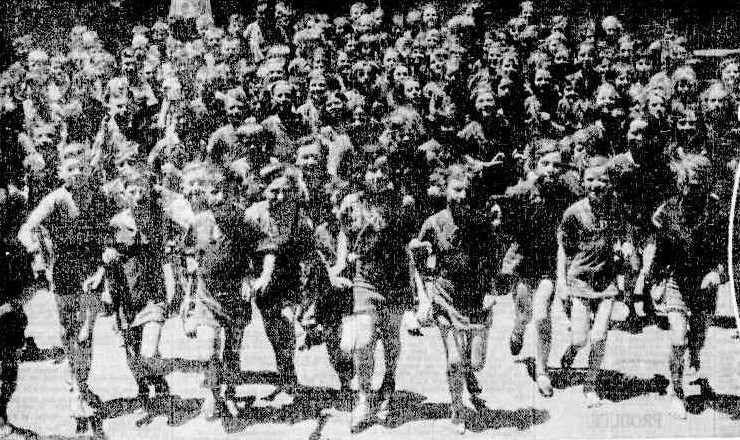

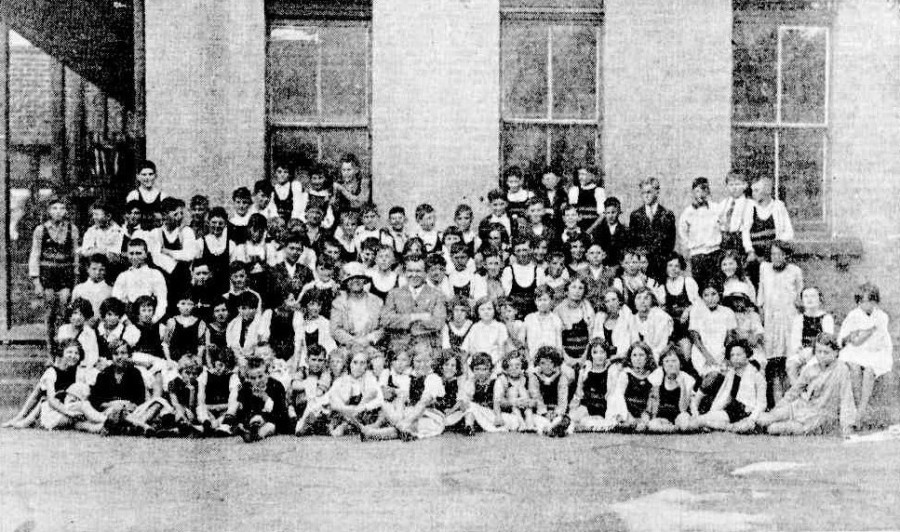

 Far West Health Scheme. MRS. S. F. DRUMMOND, whose husband, the Rev. S. Drummond, was included in the King's Birthday honors. Many country hearts were glad to see the name of the Rev. Stanley Drummond, M.B.E., among the King's Birthday honors list. The honor is really a dual one, for Mrs. Drummond has shared in the fine work of her husband. To be freed from physical ills and able to look forward to a normal, healthy and happy life, has been the lot of many hundreds of children in the out-back districts, who have come under the ministrations of the Far West Children's Health Scheme.
Far West Health Scheme. MRS. S. F. DRUMMOND, whose husband, the Rev. S. Drummond, was included in the King's Birthday honors. Many country hearts were glad to see the name of the Rev. Stanley Drummond, M.B.E., among the King's Birthday honors list. The honor is really a dual one, for Mrs. Drummond has shared in the fine work of her husband. To be freed from physical ills and able to look forward to a normal, healthy and happy life, has been the lot of many hundreds of children in the out-back districts, who have come under the ministrations of the Far West Children's Health Scheme. Kingsford Smith's Generosity. THE N.S.W. Far West Children's Health scheme has benefited by over £1100 as the result of Air Commodore Sir Charles Kingsford Smith handing over to it the proceeds of a fund inaugurated by the citizens to recognise his air services to Australia. The money, which was to have been spent on a testimonial to the airman, will now be devoted to the erection of a building for the care of feeble country children. The organising committee, of which the Lord Mayor (Alderman Hagon)was chairman, decided that some memento should be presented to Sir Charles Kingsford Smith, chiefly for his generous action, and at a recent representative gathering at the Town Hall recently he was given a figured maple writing desk and chair with his name inscribed on a gold plate fitted to the top of the table. Men and Matters. (1933, July 26). Worker (Brisbane, Qld. : 1890 - 1955), p. 13. Retrieved from http://nla.gov.au/nla.news-article71140452
Kingsford Smith's Generosity. THE N.S.W. Far West Children's Health scheme has benefited by over £1100 as the result of Air Commodore Sir Charles Kingsford Smith handing over to it the proceeds of a fund inaugurated by the citizens to recognise his air services to Australia. The money, which was to have been spent on a testimonial to the airman, will now be devoted to the erection of a building for the care of feeble country children. The organising committee, of which the Lord Mayor (Alderman Hagon)was chairman, decided that some memento should be presented to Sir Charles Kingsford Smith, chiefly for his generous action, and at a recent representative gathering at the Town Hall recently he was given a figured maple writing desk and chair with his name inscribed on a gold plate fitted to the top of the table. Men and Matters. (1933, July 26). Worker (Brisbane, Qld. : 1890 - 1955), p. 13. Retrieved from http://nla.gov.au/nla.news-article71140452 FAR WEST CHILDREN'S APPEAL. From left: Sir Charles Kingsford Smith, the Lord Mayor (Alderman Hagon), and Rev. S. G. Drummond at the Town Hall yesterday. FAR WEST CHILDREN'S APPEAL. (1933, July 22). The Sydney Morning Herald (NSW : 1842 - 1954), p. 16. Retrieved from http://nla.gov.au/nla.news-article16993205
FAR WEST CHILDREN'S APPEAL. From left: Sir Charles Kingsford Smith, the Lord Mayor (Alderman Hagon), and Rev. S. G. Drummond at the Town Hall yesterday. FAR WEST CHILDREN'S APPEAL. (1933, July 22). The Sydney Morning Herald (NSW : 1842 - 1954), p. 16. Retrieved from http://nla.gov.au/nla.news-article16993205
 FAR WEST HEALTH SCHEME.
FAR WEST HEALTH SCHEME. Rev. Stanley G. Drummond, Founder of the Far West Children's Health Scheme, has passed over to the Great Beyond, beloved and remembered by people scattered in all parts of New South Wales. Fifty-eight years old when the Call came, this fine self-sacrificing personality spent the adult years of his life doing good to others, irrespective of creed, class or color. There was nothing too strenuous, too hazardous, or too costly where humanity was concerned that Stanley Drummond did not undertake to accomplish.
Rev. Stanley G. Drummond, Founder of the Far West Children's Health Scheme, has passed over to the Great Beyond, beloved and remembered by people scattered in all parts of New South Wales. Fifty-eight years old when the Call came, this fine self-sacrificing personality spent the adult years of his life doing good to others, irrespective of creed, class or color. There was nothing too strenuous, too hazardous, or too costly where humanity was concerned that Stanley Drummond did not undertake to accomplish.